BMW Z8 2000 Owner's Manual
Manufacturer: BMW, Model Year: 2000, Model line: Z8, Model: BMW Z8 2000Pages: 172, PDF Size: 1.9 MB
Page 21 of 172
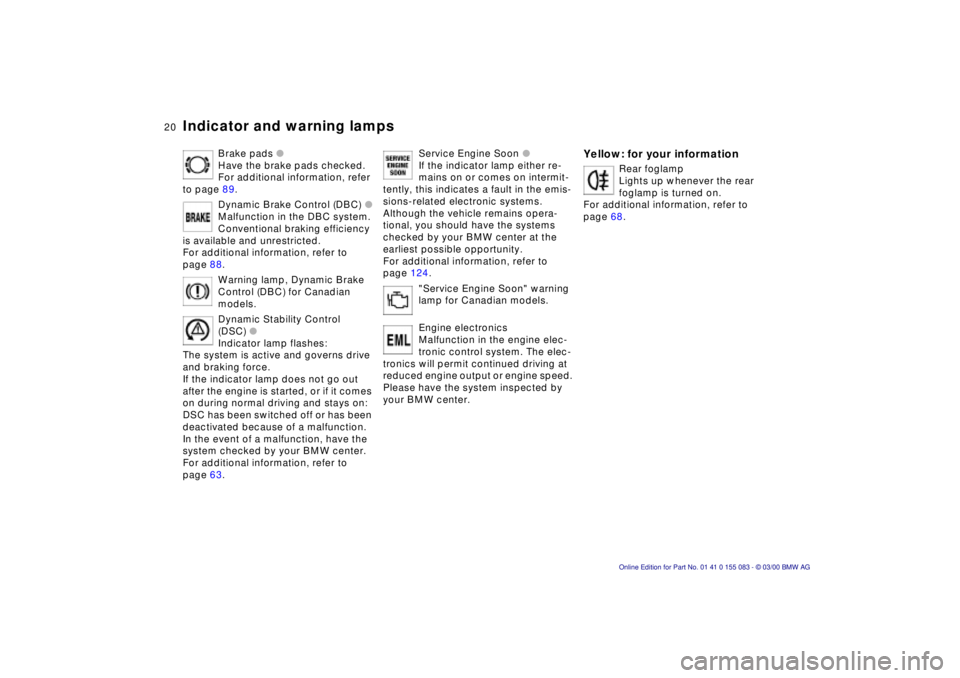
20n
Indicator and warning lamps
Brake pads
l
Have the brake pads checked.
For additional information, refer
to page 89.
Dynamic Brake Control (DBC) l
Malfunction in the DBC system.
Conventional braking efficiency
is available and unrestricted.
For additional information, refer to
page 88.
Warning lamp, Dynamic Brake
Control (DBC) for Canadian
models.
Dynamic Stability Control
(DSC) l
Indicator lamp flashes:
The system is active and governs drive
and braking force.
If the indicator lamp does not go out
after the engine is started, or if it comes
on during normal driving and stays on:
DSC has been switched off or has been
deactivated because of a malfunction.
In the event of a malfunction, have the
system checked by your BMW center.
For additional information, refer to
page 63.
Service Engine Soon l
If the indicator lamp either re-
mains on or comes on intermit-
tently, this indicates a fault in the emis-
sions-related electronic systems.
Although the vehicle remains opera-
tional, you should have the systems
checked by your BMW center at the
earliest possible opportunity.
For additional information, refer to
page 124.
"Service Engine Soon" warning
lamp for Canadian models.
Engine electronics
Malfunction in the engine elec-
tronic control system. The elec-
tronics will permit continued driving at
reduced engine output or engine speed.
Please have the system inspected by
your BMW center.
Yellow: for your information
Rear foglamp
Lights up whenever the rear
foglamp is turned on.
For additional information, refer to
page 68.
Page 22 of 172
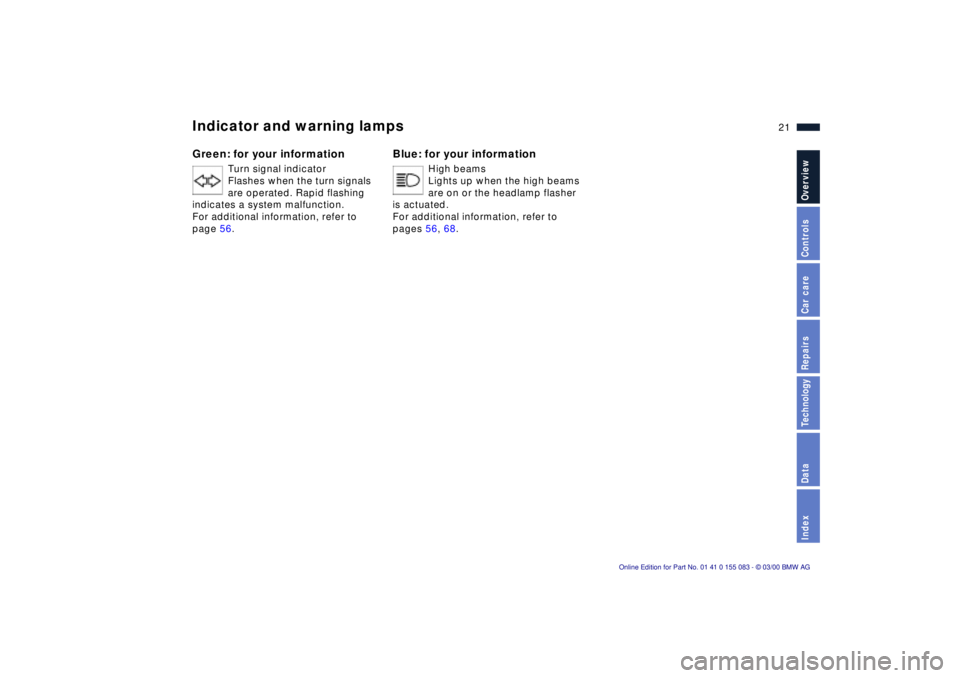
21n
IndexDataTechnologyRepairsCar careControlsOverview
Indicator and warning lampsGreen: for your information
Turn signal indicator
Flashes when the turn signals
are operated. Rapid flashing
indicates a system malfunction.
For additional information, refer to
page 56.
Blue: for your information
High beams
Lights up when the high beams
are on or the headlamp flasher
is actuated.
For additional information, refer to
pages 56, 68.
Page 23 of 172
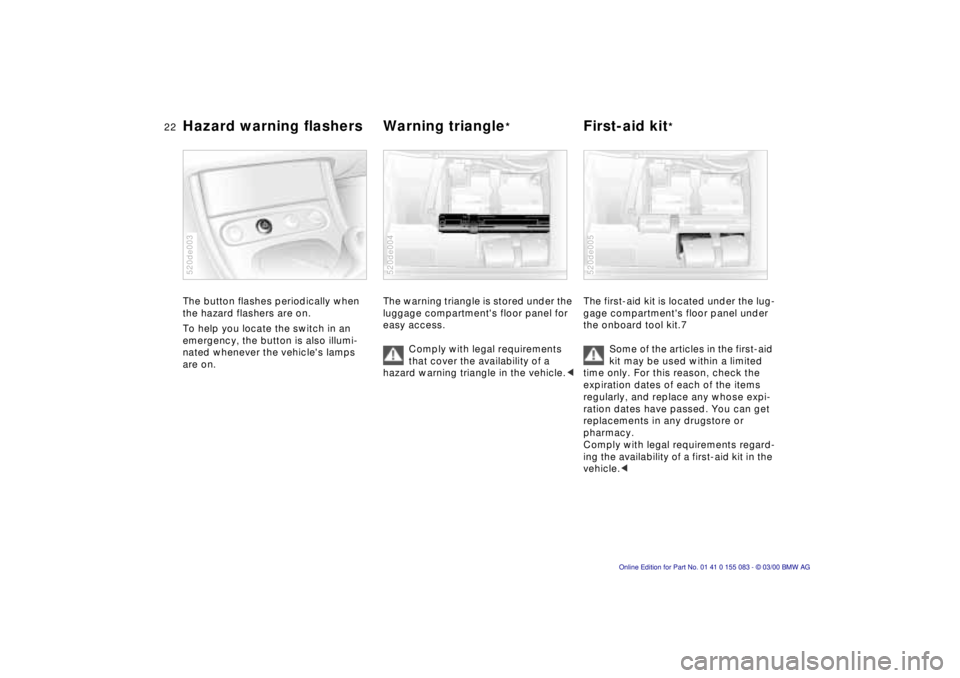
22n
Hazard warning flashers Warning triangle
*
First-aid kit
*
The button flashes periodically when
the hazard flashers are on.
To help you locate the switch in an
emergency, the button is also illumi-
nated whenever the vehicle's lamps
are on.520de003
The warning triangle is stored under the
luggage compartment's floor panel for
easy access.
Comply with legal requirements
that cover the availability of a
hazard warning triangle in the vehicle.<520de004
The first-aid kit is located under the lug-
gage compartment's floor panel under
the onboard tool kit.7
Some of the articles in the first-aid
kit may be used within a limited
time only. For this reason, check the
expiration dates of each of the items
regularly, and replace any whose expi-
ration dates have passed. You can get
replacements in any drugstore or
pharmacy.
Comply with legal requirements regard-
ing the availability of a first-aid kit in the
vehicle.< 520de005
Page 24 of 172
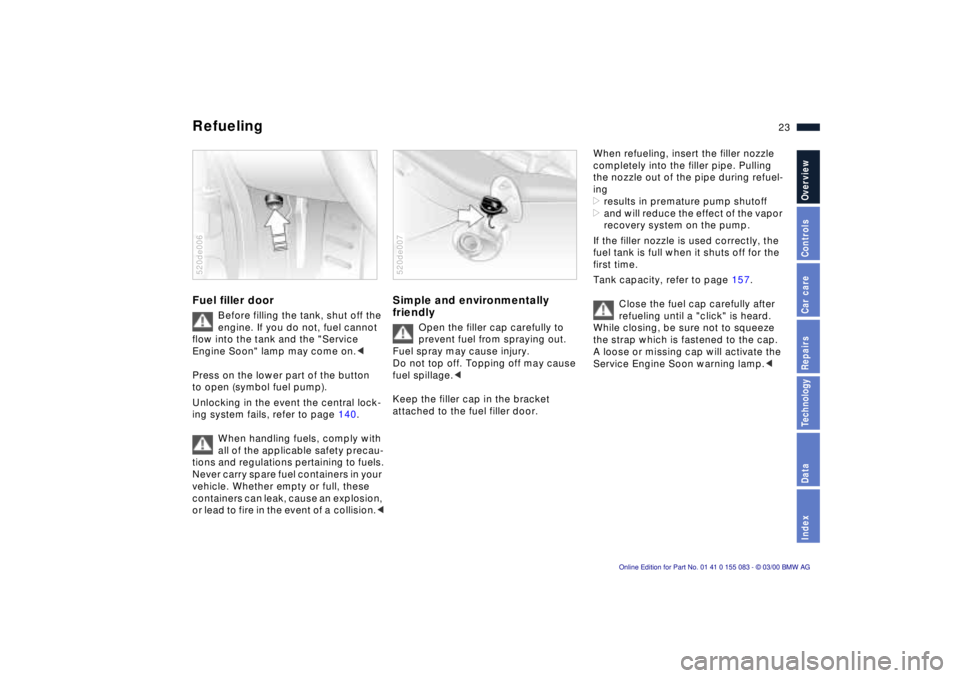
23n
IndexDataTechnologyRepairsCar careControlsOverview
Refueling Fuel filler door
Before filling the tank, shut off the
engine. If you do not, fuel cannot
flow into the tank and the "Service
Engine Soon" lamp may come on.<
Press on the lower part of the button
to open (symbol fuel pump).
Unlocking in the event the central lock-
ing system fails, refer to page 140.
When handling fuels, comply with
all of the applicable safety precau-
tions and regulations pertaining to fuels.
Never carry spare fuel containers in your
vehicle. Whether empty or full, these
containers can leak, cause an explosion,
or lead to fire in the event of a collision.<
520de006
Simple and environmentally
friendly
Open the filler cap carefully to
prevent fuel from spraying out.
Fuel spray may cause injury.
Do not top off. Topping off may cause
fuel spillage.<
Keep the filler cap in the bracket
attached to the fuel filler door.
520de007
When refueling, insert the filler nozzle
completely into the filler pipe. Pulling
the nozzle out of the pipe during refuel-
ing
>results in premature pump shutoff
>and will reduce the effect of the vapor
recovery system on the pump.
If the filler nozzle is used correctly, the
fuel tank is full when it shuts off for the
first time.
Tank capacity, refer to page 157.
Close the fuel cap carefully after
refueling until a "click" is heard.
While closing, be sure not to squeeze
the strap which is fastened to the cap.
A loose or missing cap will activate the
Service Engine Soon warning lamp.<
Page 25 of 172
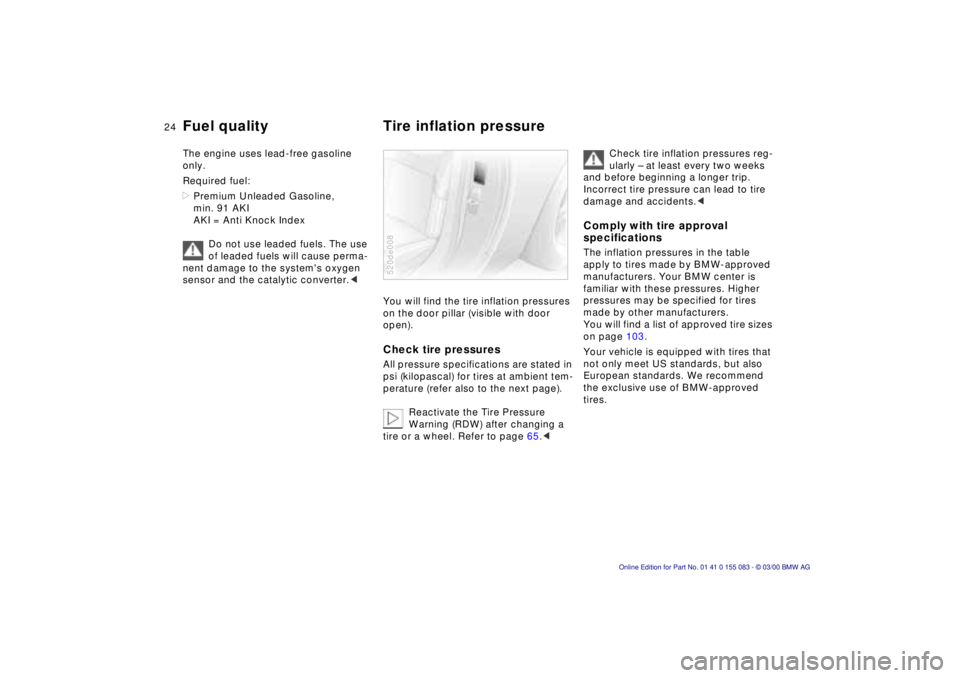
24n
Fuel quality Tire inflation pressure The engine uses lead-free gasoline
only.
Required fuel:
>Premium Unleaded Gasoline,
min. 91 AKI
AKI = Anti Knock Index
Do not use leaded fuels. The use
of leaded fuels will cause perma-
nent damage to the system's oxygen
sensor and the catalytic converter.<
You will find the tire inflation pressures
on the door pillar (visible with door
open).Check tire pressuresAll pressure specifications are stated in
psi (kilopascal) for tires at ambient tem-
perature (refer also to the next page).
Reactivate the Tire Pressure
Warning (RDW) after changing a
tire or a wheel. Refer to page 65.<520de008
Check tire inflation pressures reg-
ularly Ð at least every two weeks
and before beginning a longer trip.
Incorrect tire pressure can lead to tire
damage and accidents.<
Comply with tire approval
specificationsThe inflation pressures in the table
apply to tires made by BMW-approved
manufacturers. Your BMW center is
familiar with these pressures. Higher
pressures may be specified for tires
made by other manufacturers.
You will find a list of approved tire sizes
on page 103.
Your vehicle is equipped with tires that
not only meet US standards, but also
European standards. We recommend
the exclusive use of BMW-approved
tires.
Page 26 of 172
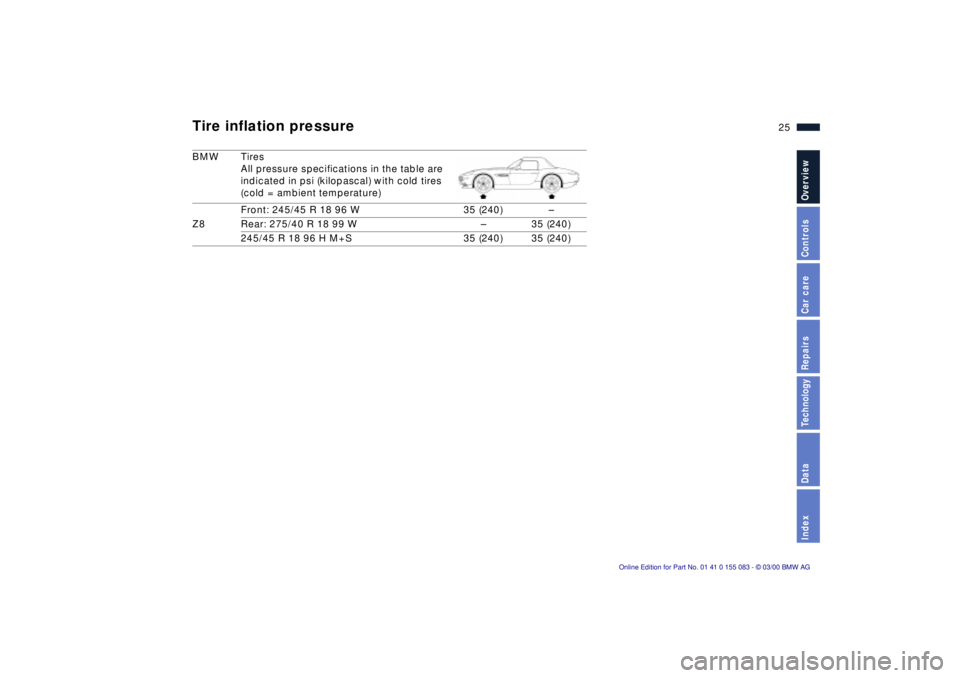
25n
IndexDataTechnologyRepairsCar careControlsOverview
Tire inflation pressureBMW Tires
All pressure specifications in the table are
indicated in psi (kilopascal) with cold tires
(cold = ambient temperature)
Z8Front: 245/45 R 18 96 W 35 (240) Ð
Rear: 275/40 R 18 99 W Ð 35 (240)
245/45 R 18 96 H M+S 35 (240) 35 (240)
Page 27 of 172
26n
Locks and security systems:
Keys28
Electronic vehicle
immobilizer29
Central locking system30
Opening and closing Ð from
outside30
Using the key30
Using the remote control31
Opening and closing Ð from
inside34
Luggage compartment lid35
Alarm system36
Electric power windows38
The automatic convertible
top39
Adjustments:
Seats43
Steering wheel45
Mirrors45
Car Memory, Key Memory46
Passenger safety systems:
Safety belts48
Airbags49
Child restraints51
Child seat safety52
Controls
Page 28 of 172
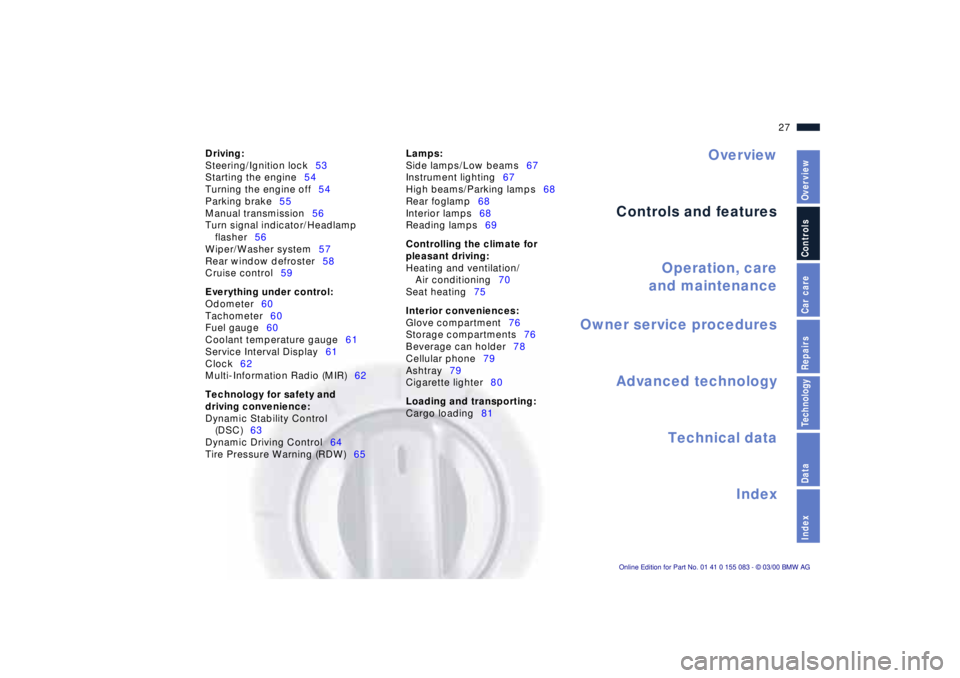
Overview
Controls and features
Operation, care
and maintenance
Owner service procedures
Technical data
Index Advanced technology
27n
IndexDataTechnologyRepairsCar careControlsOverview
Driving:
Steering/Ignition lock53
Starting the engine54
Turning the engine off54
Parking brake55
Manual transmission56
Turn signal indicator/Headlamp
flasher56
Wiper/Washer system57
Rear window defroster58
Cruise control59
Everything under control:
Odometer60
Tachometer60
Fuel gauge60
Coolant temperature gauge61
Service Interval Display61
Clock62
Multi-Information Radio (MIR)62
Technology for safety and
driving convenience:
Dynamic Stability Control
(DSC)63
Dynamic Driving Control64
Tire Pressure Warning (RDW)65Lamps:
Side lamps/Low beams67
Instrument lighting67
High beams/Parking lamps68
Rear foglamp68
Interior lamps68
Reading lamps69
Controlling the climate for
pleasant driving:
Heating and ventilation/
Air conditioning70
Seat heating75
Interior conveniences:
Glove compartment76
Storage compartments76
Beverage can holder78
Cellular phone79
Ashtray79
Cigarette lighter80
Loading and transporting:
Cargo loading81
Page 29 of 172
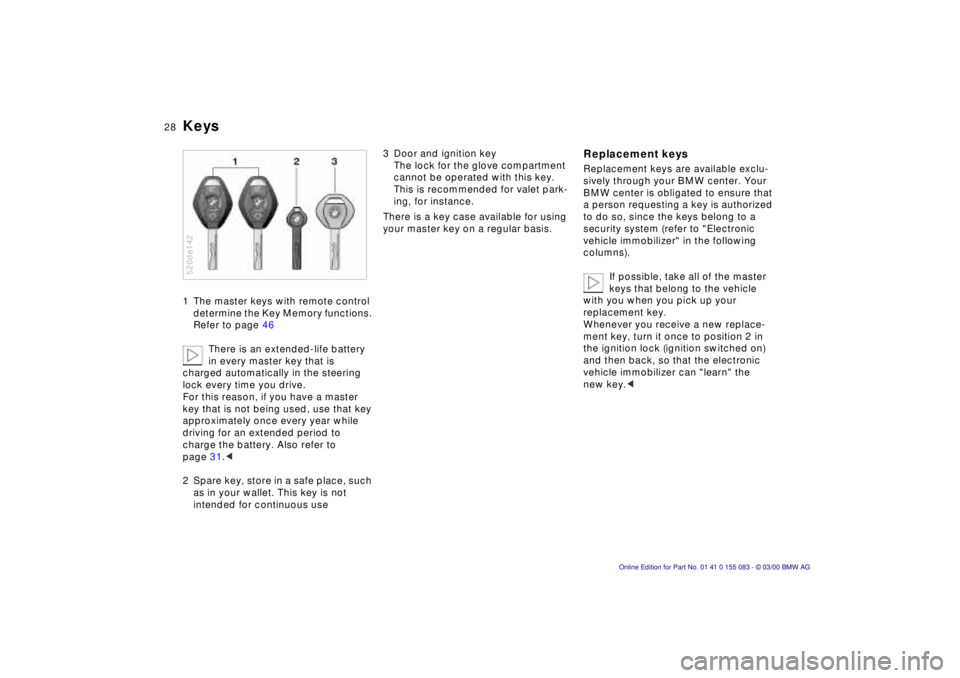
28n
Keys1 The master keys with remote control
determine the Key Memory functions.
Refer to page 46
There is an extended-life battery
in every master key that is
charged automatically in the steering
lock every time you drive.
For this reason, if you have a master
key that is not being used, use that key
approximately once every year while
driving for an extended period to
charge the battery. Also refer to
page 31.<
2 Spare key, store in a safe place, such
as in your wallet. This key is not
intended for continuous use 520de142
3 Door and ignition key
The lock for the glove compartment
cannot be operated with this key.
This is recommended for valet park-
ing, for instance.
There is a key case available for using
your master key on a regular basis.
Replacement keysReplacement keys are available exclu-
sively through your BMW center. Your
BMW center is obligated to ensure that
a person requesting a key is authorized
to do so, since the keys belong to a
security system (refer to "Electronic
vehicle immobilizer" in the following
columns).
If possible, take all of the master
keys that belong to the vehicle
with you when you pick up your
replacement key.
Whenever you receive a new replace-
ment key, turn it once to position 2 in
the ignition lock (ignition switched on)
and then back, so that the electronic
vehicle immobilizer can "learn" the
new key.<
Page 30 of 172
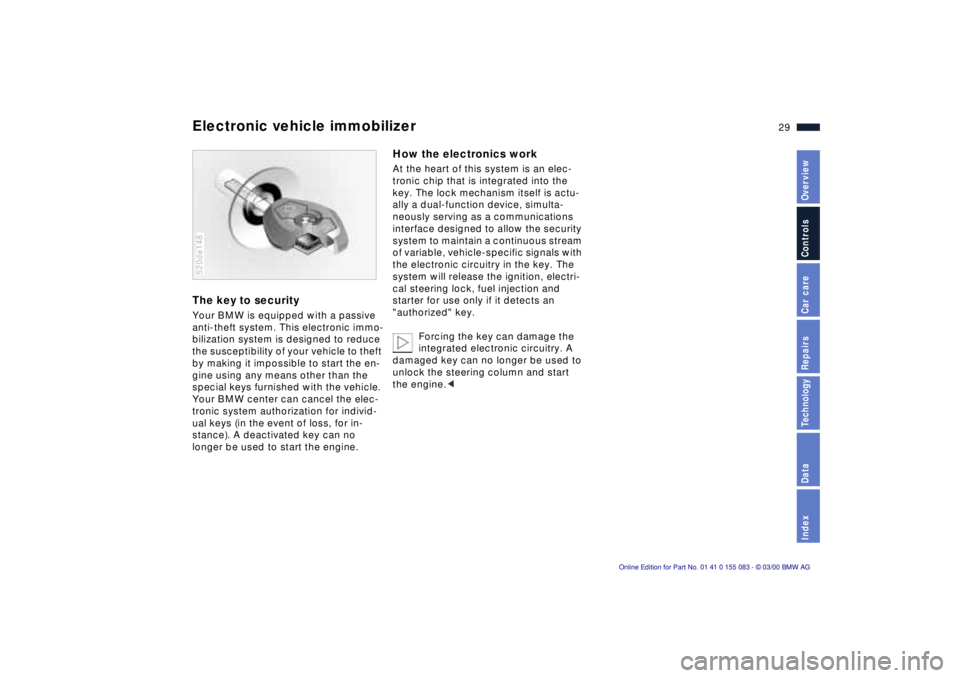
29n
IndexDataTechnologyRepairsCar careControlsOverview
Electronic vehicle immobilizer The key to securityYour BMW is equipped with a passive
anti-theft system. This electronic immo-
bilization system is designed to reduce
the susceptibility of your vehicle to theft
by making it impossible to start the en-
gine using any means other than the
special keys furnished with the vehicle.
Your BMW center can cancel the elec-
tronic system authorization for individ-
ual keys (in the event of loss, for in-
stance). A deactivated key can no
longer be used to start the engine.520de148
How the electronics workAt the heart of this system is an elec-
tronic chip that is integrated into the
key. The lock mechanism itself is actu-
ally a dual-function device, simulta-
neously serving as a communications
interface designed to allow the security
system to maintain a continuous stream
of variable, vehicle-specific signals with
the electronic circuitry in the key. The
system will release the ignition, electri-
cal steering lock, fuel injection and
starter for use only if it detects an
"authorized" key.
Forcing the key can damage the
integrated electronic circuitry. A
damaged key can no longer be used to
unlock the steering column and start
the engine.<